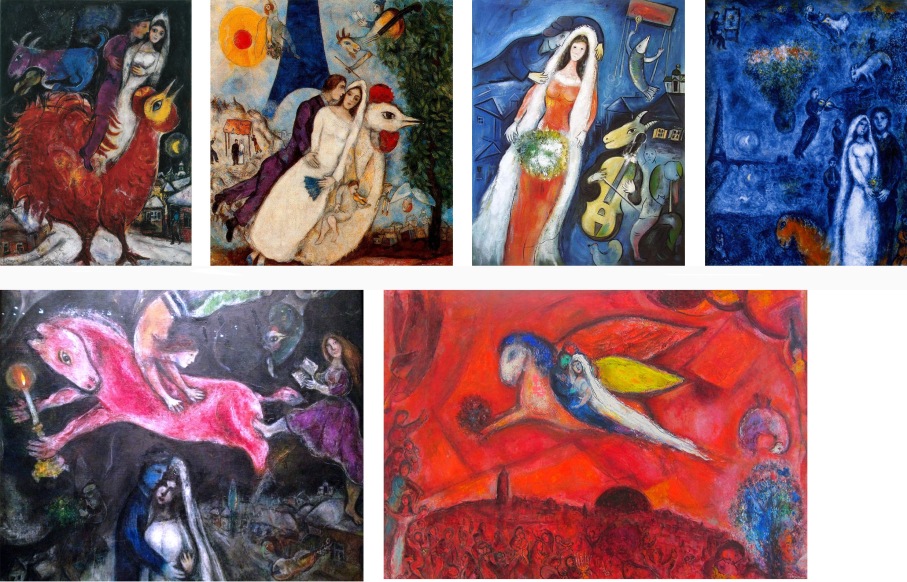Well… that’s the direction that my convoluted brain wanders while watching this Poirot episode… (Note: associations are my own and are not intended to reflect genuine intent on the part of script writers or art departments.) 🙂
The only thing that comes as close to the awesomeness of the famously-moustachioed Dying Gaul as a focal statue in the chess tournament scene of The Big Four, is the use of Chagall’s “Feathers in Bloom” in The Double Clue.
Before reaching the gallery interior, previous conversations with the Countess had emphasized certain points of commonality between the characters: the sad and lonely aspects of foreign exile. Despite the mutual appreciation of the painting and the reference to Chagall’s own “exile” from Russia, the gallery scene in general focuses more on the differences in personality and background between the pair. Poirot offers to take the Countess to the Tate to see the Turner landscapes– sublime, comparatively bourgeois, and quintessentially English. She voices a preference for the more “exciting” and avant-garde continental Expressionists, which Poirot only appreciates “in part.” (At this point, he gently chides her for using his first name, maintaining a wholly formal address between them.) The scene concludes with Poirot demonstrating his cred as “the most famous detective in England” by hinting that he already knows of her guilt. This all resolves with Poirot maintaining himself on the side of England, as it were, while able (as a fellow foreign refugee) to grasp something of the psychology of the criminal.
That’s about as far as the episode goes with Chagall. But there are some other interesting things about it that come to bear on some of the story’s themes.
“Feathers in Bloom” features some of Chagall’s most commonly-used symbols. The moon is usually present at the meeting of lovers. The horse (in this case, with the legs of a man) represents ideas such as strength, virility, and freedom. The chicken or rooster is used throughout his work in two senses: first, in terms of fertility and also associated with lovers; secondly, as a Jewish symbol (along with the goat) for the expiation of guilt and sin, in connection with Yom Kippur. More on that later.
You can see typical examples of all of these symbols together in Chagall’s works, such as the following:
…But of course, those Chagalls all share another iconic visual that is (perhaps sadly) lacking in the “Feathers in Bloom” painting encountered by Poirot and the Countess. Namely, this one:
One could, perhaps, read “Feathers in Bloom” in this context as a meeting of love interests that will not result in that idyllic, dream-like state with bride and groom flying off into the sunset.
But speaking of goats and chickens…
Chagall’s Hasidic Jewish background is one of the preeminent influences of his artwork, and the goat (or, by more modern parallel, the chicken) as symbols of sacrifice and atonement happen to come to bear on some of the story’s themes, as well. In ancient times, the Day of Atonement would involve the sacrifice of a goat, and the binding of a second goat in scarlet which would then be driven away into the remote wilderness as a sign of the expiation of guilt. This is where we get the term scapegoat. The scapegoat appears throughout The Double Clue.
Japp: “The Commissioner’s come down on me. He wants action. If not, he’s going to have to give them a scapegoat.”
Poirot: “A goat?”
Japp: “Me.”
In the episode, the propitiation takes the form of the Countess relinquishing her stolen goods, Poirot “covering” for her, and transferring the guilt onto the tramp as a scapegoat. However, like the scapegoat, the Countess herself must be driven away, never to return to the society.
Yes, I know I’m reading a lot into it. Blame whoever thought to stick Marc Chagall into the script!! 🙂 🙂 🙂 Where there is Chagall, the symbols start flying!
Speaking of Chagall and all the random mental associations he seems to conjure up, we could finally note a few coincidences of his family history. Born and raised in Russia, of a Lithuanian Jewish family (Moishe Shagal russified to Mark Shagalov). Found his way to Paris and its creative epicenters, where the family name was rendered as the French-sounding Chagall. From Paris, moved on again into the English-speaking world, where he settled for good. If that doesn’t remind you of a certain unnamed actor’s family history, well…





What about the name “Vera”? A derivative of truth in Latin. Our Ms. Christie is so clever.
LikeLiked by 1 person
Pingback: Regarding The Double Clue – A Poirot Podcast